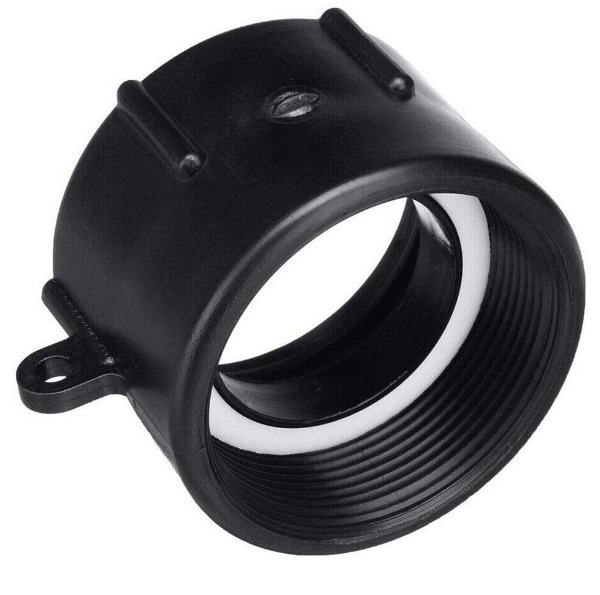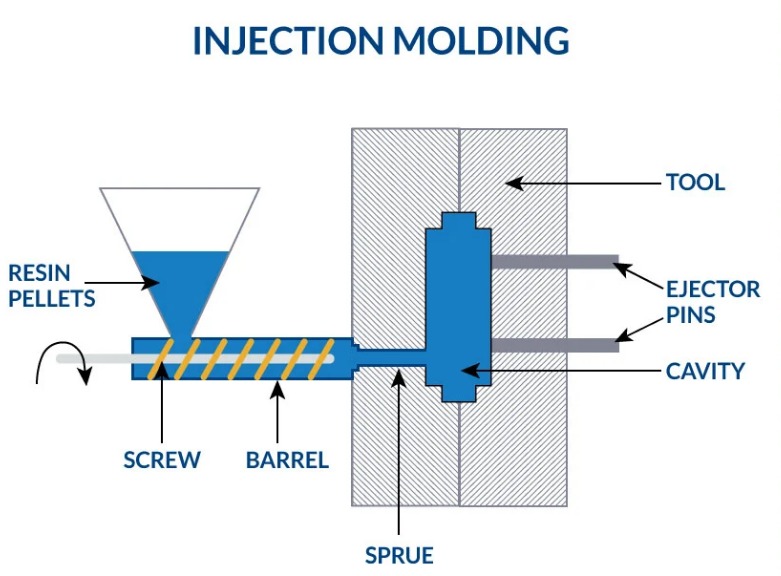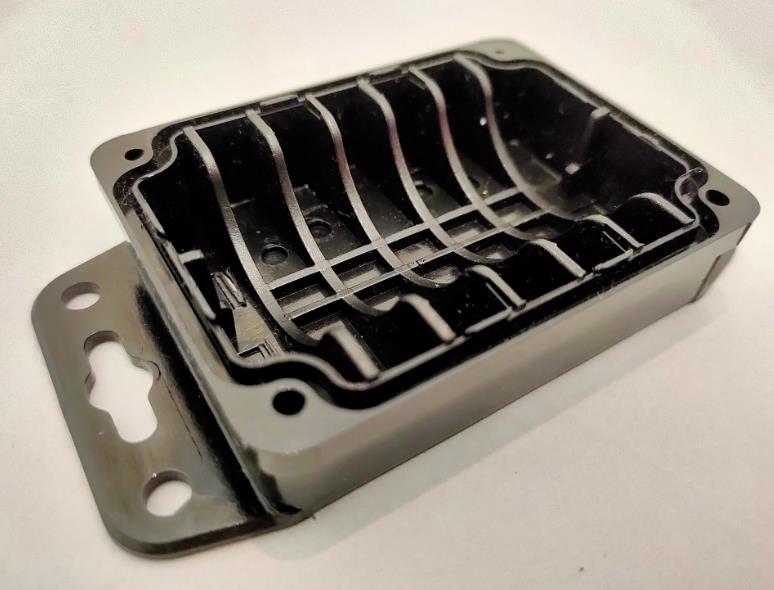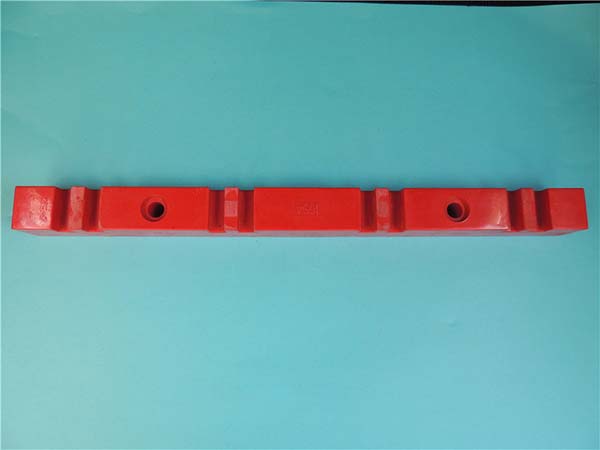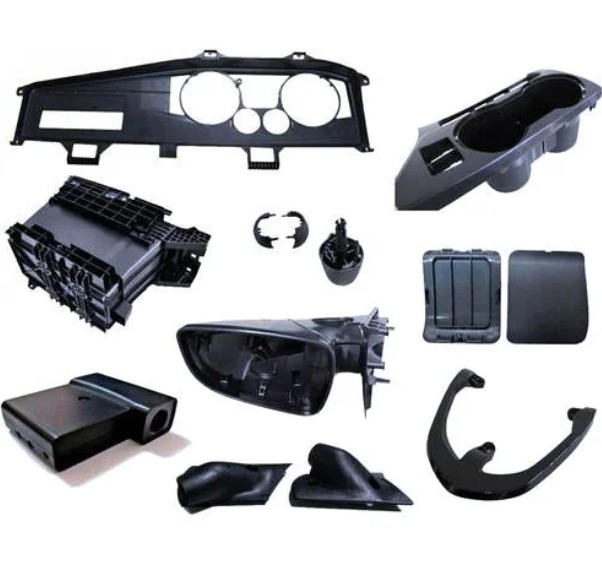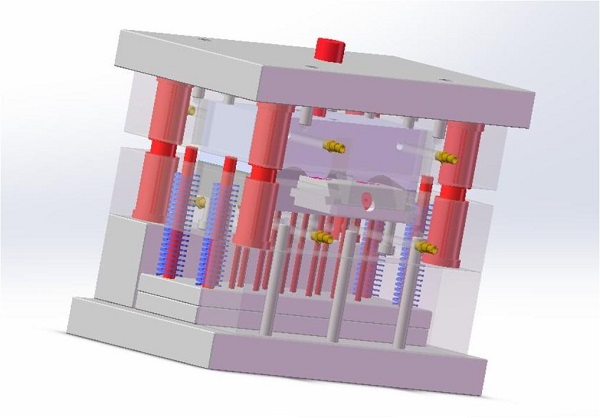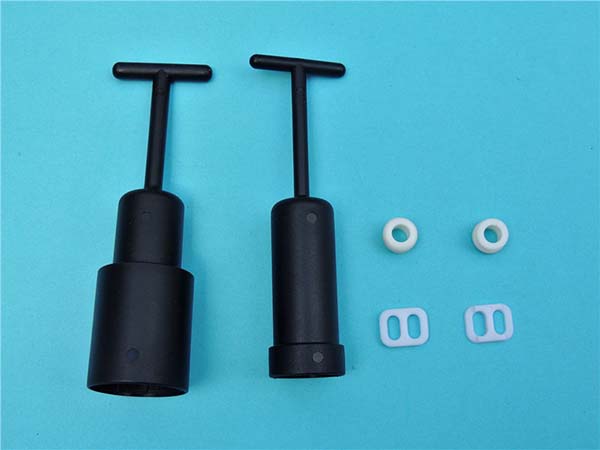What Exactly are Injection Blow Molding Products?
Injection blow molding products are a type of plastic product created through a specialized manufacturing process. This process combines the principles of injection molding and blow molding to produce high - quality, precision - engineered plastic items.
1. The Injection Blow Molding Process in Detail
- Stage 1: Injection Molding
- First, molten plastic is injected into a pre - form mold under high pressure. This forms a parison, which is a tube - like piece of plastic with a closed end. For example, if you are making a plastic bottle, the parison will have the basic shape of the bottle's neck and a small part of the body, with the bottom end sealed. This stage is similar to traditional injection molding, where the plastic material (such as polyethylene, polypropylene, or PET) is melted and forced into a mold cavity. The advantage of this initial injection step is that it can create very precise details, such as threaded necks on bottles, which are difficult to achieve with other blow - molding methods.
- Stage 2: Blow Molding
- Once the parison is formed, it is transferred to a blow - mold cavity. Hot air is then blown into the parison, causing it to expand and take the shape of the larger blow - mold. This is how the final shape of the product, like the body of the bottle, is achieved. The stretching of the plastic during this blow - molding stage also enhances the physical properties of the plastic, such as its strength and clarity.
2. Comparison with Other Molding Processes
- Extrusion Blow Molding
- In extrusion blow molding, a continuous tube of molten plastic (the parison) is extruded downward. A mold then closes around the parison, and air is blown into it to form the final product. One key difference from injection blow molding is in the formation of the parison. In extrusion blow molding, the parison is less precise in its initial shape compared to the injection - molded parison. For example, extrusion - blow - molded products may have less accurate neck details. Injection blow - molded products are often preferred for applications where high - precision details are required, such as in pharmaceutical packaging, where accurate closures are crucial for product safety.
- Another difference lies in the production speed. Injection blow molding can be faster for high - volume production of small to medium - sized products, while extrusion blow molding may be more suitable for larger, less - precise items like large industrial containers.
- Stretch Blow Molding
- Stretch blow molding involves stretching the plastic in two directions (axially and radially) during the blow - molding process. This is commonly used for making PET bottles for beverages. Although injection blow molding also involves stretching the plastic during the blow - molding stage, stretch blow molding focuses more on the biaxial stretching to enhance properties like the gas barrier properties of the plastic. Injection blow - molded products may not always require the same level of biaxial stretching as stretch - blow - molded products. For instance, injection blow - molded products can be made with a wider range of plastic materials and are more versatile in terms of shape complexity, while stretch blow - molded products are mainly used for applications where excellent gas - barrier properties are a top priority, such as carbonated beverage bottles.
The Intricate Process of Injection Blow Molding
The injection blow molding process is a multi - step procedure that requires precision and careful control. Here is a more in - depth look at each stage:
Injection Stage
- Material Preparation
- First, the plastic resin pellets are fed into a hopper. These pellets are then heated in a barrel until they reach a molten state. The temperature at which the plastic melts depends on the type of plastic. For example, polyethylene (PE) typically melts in the range of 120 - 200°C, while polypropylene (PP) melts around 160 - 170°C.
- Injection into the Pre - form Mold
- Once molten, the plastic is injected into a pre - form mold using a reciprocating screw or a plunger. The high - pressure injection ensures that the plastic fills every detail of the pre - form mold cavity. The pressure used can range from 50 to 200 megapascals (MPa), depending on the complexity of the pre - form design and the plastic material. As shown in Figure 1 below, the injection system forces the molten plastic into the pre - form mold, creating the initial parison shape.
- The pre - form mold is designed to create the neck and a small portion of the body of the final product. For a plastic bottle, the pre - form will have the threaded neck and a short cylindrical section, which will later be expanded during the blow - molding stage.
Blow Molding Stage
- Transfer to the Blow - mold
- After the parison is formed in the pre - form mold, it is transferred, while still hot and in a semi - molten state, to the blow - mold. This transfer is usually done using a robotic arm or a mechanical transfer system to ensure accuracy and speed.
- Blowing the Parison
- Once the parison is in the blow - mold, hot air is introduced into the parison through a blow pin. The pressure of the hot air, typically in the range of 2 - 10 MPa, causes the parison to expand and conform to the shape of the blow - mold. This process is illustrated in Figure 2.
- The stretching of the plastic during this stage not only gives the product its final shape but also improves its mechanical properties. For instance, the biaxial stretching (both axially and radially) of the plastic in a bottle increases its strength and makes it more resistant to impact and puncture.
Demolding Stage
- Cooling the Product
- After the plastic has taken the shape of the blow - mold, the product needs to cool down. Cooling channels in the blow - mold help dissipate the heat, solidifying the plastic. The cooling time can vary from a few seconds to several minutes, depending on the size and thickness of the product. Thicker - walled products or products made from plastics with a high melting point will generally require longer cooling times.
- Ejecting the Product
- Once cooled, the blow - mold opens, and the finished product is ejected. Ejector pins or other ejection mechanisms are used to push the product out of the mold. The product is then ready for further processing, such as trimming any excess material, labeling, or quality inspection. Figure 3 shows the demolding process.
Diverse Applications of Injection Blow Molding Products
Injection blow molding products have found their way into a wide range of industries due to their unique features and cost - effectiveness.
Packaging Industry
- Cosmetic Bottles
- In the cosmetic industry, injection blow - molded products are highly favored for packaging. For example, many high - end perfume bottles are made through injection blow molding. These bottles can have complex shapes, such as those with curved bodies and fine - detailed necks. The high - precision dimensions of injection blow - molded products ensure that the bottle caps fit perfectly, preventing any leakage of the precious perfume inside. A study by a market research firm showed that over 60% of luxury cosmetic brands use injection blow - molded plastic bottles for their products, as they can provide a high - end look with smooth surfaces and consistent wall thickness. Figure 4 shows an example of an injection blow - molded cosmetic bottle.
- Pharmaceutical Bottles
- In the pharmaceutical sector, injection blow - molded bottles are used to store tablets, capsules, and liquid medications. The tight tolerance and uniform wall thickness of these bottles are crucial for maintaining the integrity of the drugs. For instance, bottles for storing liquid medications need to be air - tight and have a consistent wall thickness to prevent any breakage during transportation. According to the Pharmaceutical Packaging Institute, about 70% of small - to medium - sized pharmaceutical bottles are injection blow - molded, as they meet the strict quality and safety standards required in the industry.
Automotive Industry
- Interior Components
- Injection blow - molded products are used for various interior components in automobiles. For example, air vents are often made using this process. The ability to create precise shapes and uniform wall thickness allows for efficient air circulation within the vehicle cabin. These air vents can be designed with complex geometries to direct the airflow precisely where it is needed. A leading automotive manufacturer reported that by using injection blow - molded air vents, they were able to improve the air - conditioning efficiency in their vehicles by 15%.
- Exterior Trim Parts
- Some exterior trim parts, such as side mirror housings, are also injection blow - molded. These parts need to be durable and have a good surface finish to withstand the harsh outdoor environment. The high - quality surface finish of injection blow - molded products makes them resistant to scratches and UV rays, ensuring a long - lasting appearance for the vehicle. Figure 5 shows an injection blow - molded side mirror housing.
Daily Necessities Industry
- Toys
- In the toy industry, injection blow - molded products are widely used. Many plastic toys, especially those with hollow bodies like action figures or toy animals, are made through this process. The ability to create complex shapes with high precision allows toy manufacturers to bring their creative designs to life. For example, a popular line of collectible toy cars has detailed exteriors and hollow interiors, which are achieved through injection blow molding. A survey of toy manufacturers found that 85% of them use injection blow - molded parts in their toys due to the cost - effectiveness and design flexibility it offers.
- Household Items
- Household items such as storage containers, soap dispensers, and spray bottles are often injection blow - molded. Storage containers made through this process have a uniform wall thickness, which ensures their durability and the ability to stack neatly. Soap dispensers can be designed with ergonomic shapes and precise dispensing mechanisms, thanks to the precision of injection blow molding. Figure 6 shows an injection blow - molded soap dispenser.
Yigu Technology's Perspective
As a non - standard plastic metal products custom Supplier, Yigu Technology has a deep - seated understanding of injection blow molding products. Our advanced mold design and manufacturing technology lies at the heart of our capabilities. We use state - of - the - art CAD/CAM software to create highly precise mold designs. For example, when designing molds for injection blow - molded products, we can optimize the mold structure to ensure uniform plastic flow during the injection stage, which in turn results in products with consistent wall thickness and high - precision dimensions.
Quality is our top - most priority, and we have a strict quality control system in place. From the selection of raw materials to the final inspection of the finished products, every step is carefully monitored. We conduct regular quality checks during the injection and blow - molding processes, such as measuring the wall thickness of the parisons and the final products using precision measuring instruments. This ensures that all our injection blow - molded products meet the highest quality standards and customer requirements. Our innovative spirit drives us to constantly explore new materials and manufacturing techniques in the field of injection blow molding, aiming to provide even better - quality products and more efficient solutions for our customers.
Frequently Asked Questions
What materials are commonly used in injection blow molding?
Commonly used materials in injection blow molding include polyethylene (PE), polypropylene (PP), polyethylene terephthalate (PET), polycarbonate (PC), and polymethyl methacrylate (PMMA).
- PE: It has good chemical resistance, flexibility, and low cost. For example, low - density PE (LDPE) is often used for making thin - walled containers like small bottles for personal care products due to its excellent flexibility, while high - density PE (HDPE) is suitable for more rigid containers such as milk jugs because of its higher strength and better chemical resistance.
- PP: PP has a high melting point, good heat resistance, and is relatively lightweight. It is used in applications like food containers and automotive components. For instance, lunch boxes made of PP can withstand hot food without deforming easily, and its lightweight nature makes it an ideal choice for reducing the weight of automotive parts.
- PET: PET is known for its high strength, excellent transparency, and good gas - barrier properties. It is widely used in the beverage industry, especially for carbonated drink bottles. The high strength of PET allows the bottles to withstand the internal pressure of the carbonated beverages, and its transparency provides a clear view of the product inside.
- PC: PC has high impact resistance, heat resistance, and dimensional stability. It is used in the production of safety - related products such as automotive headlamp lenses and medical device components. The high impact resistance of PC ensures that headlamp lenses can withstand impacts from small stones on the road, and its dimensional stability is crucial for accurate fitting of medical device components.
- PMMA: PMMA, also known as acrylic, has excellent optical clarity, making it suitable for products where a high - quality visual appearance is required, such as cosmetic packaging and display components. Cosmetic jars made of PMMA can showcase the product inside with a crystal - clear view, enhancing the product's appeal.
How to ensure the quality of injection blow molding products?
To ensure the quality of injection blow molding products, several aspects need to be considered:
- Mold Design: A well - designed mold is crucial. The mold should have proper cooling channels to ensure uniform cooling of the product, which helps in achieving a uniform wall thickness. For example, using conformal cooling channels can improve the cooling efficiency and reduce the cooling time, resulting in better - quality products. The mold should also be made of high - quality materials to withstand the high pressures and temperatures during the injection and blow - molding processes.
- Raw Material Selection: Choose high - quality raw materials that meet the required specifications. Check the melt flow index, density, and other properties of the plastic resins. For instance, if the melt flow index is not within the appropriate range, it can lead to problems such as uneven filling of the mold or inconsistent wall thickness in the final product.
- Process Parameter Control: Precise control of process parameters is essential. Monitor and adjust the injection pressure, injection speed, melt temperature, and blow - molding pressure. For example, if the injection pressure is too low, the plastic may not fill the mold completely, resulting in incomplete products. On the other hand, if the blow - molding pressure is too high, it can cause the product to burst or have uneven walls.
- Quality Detection: Implement a comprehensive quality - detection system. Use techniques such as visual inspection for surface defects, dimensional measurement with precision instruments like coordinate measuring machines (CMMs) to ensure the product meets the required dimensions, and non - destructive testing methods like ultrasonic testing for internal defects. For example, in the production of medical device components, strict dimensional accuracy is required, and CMMs can accurately measure the dimensions to ensure they are within the tolerance range.
